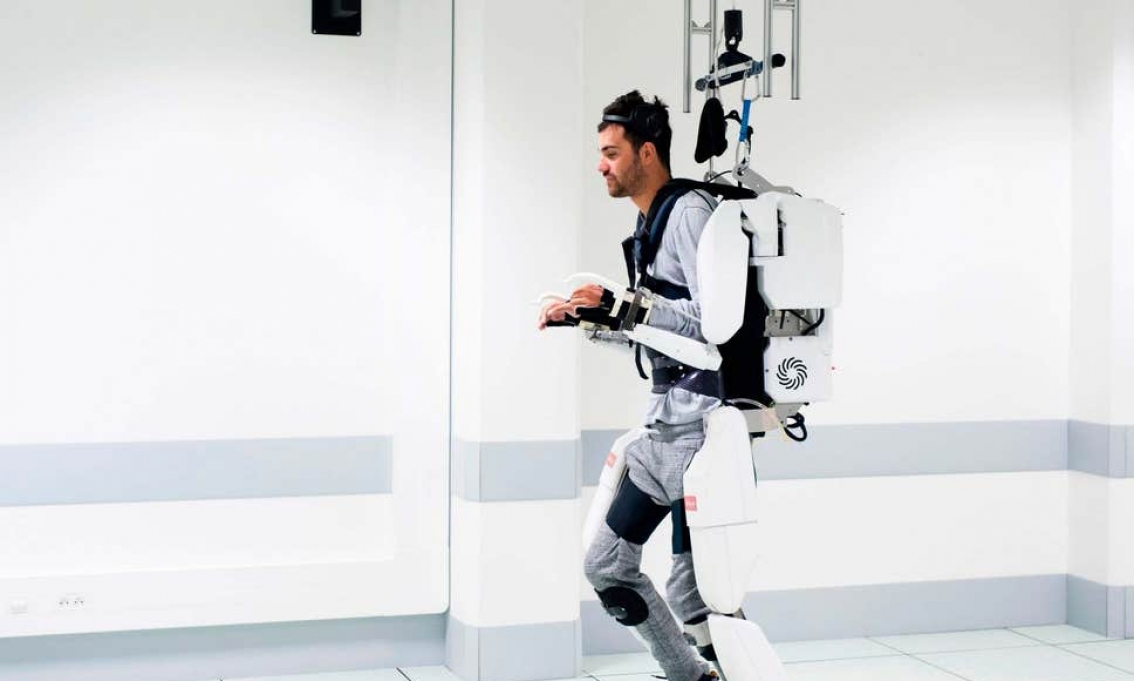 Like "walking on the moon", Thibault (30) finally felt what it feels like to walk again. (Image via The Independent)
Like "walking on the moon", Thibault (30) finally felt what it feels like to walk again. (Image via The Independent)
It's a miracle! A paralyzed man walks after exoskeleton implant
A quadriplegic man, paralyzed from shoulders down to the toes, had a chance to finally walk the earth once more. An experiment conducted in France at the University of Grenoble saw a quadriplegic man as a participant for the exoskeleton experiment. The result was published in The Lancet Neurology journal on Thursday.After a two-year trial, the 30-year-old man, known as Thibault, finally made it to the experiment. Using sensors planted in his brain, Thibault could make his paralyzed move again by sending messages to a 65kg exoskeleton body.
Thibault felt like Neil Armstrong at that time. Supported by a harness mounted over the ceiling, he described the feeling as if he was walking on the moon.
The experiment involved surgery on Thibault’s brain. The researchers planted two implants on the surface of Thibault’s brain, covering the section of the brain that governs movement. One implant consisted of about 64 electrodes that detect brain signals and share the signal to the computer. The computer translated the signal into a message that would be delivered into the exoskeleton.
So, say, if Thibault thinks “walk forward”, the computer would translate the brain signal into a command for the exoskeleton to move his legs forward.
A bit about Thibault, he was an optician before a 15m fall rendered him paralyzed. He took the exoskeleton trial in 2017 by controlling a game character with his brain before moving on to the current exoskeleton.
While Thibault was having a good time with the legs, it took him much longer to learn how to send a command through his arms. It was caused by the complexity of muscle and movement that requires more command than legs.
Another drawback of the experiment was that Thibaut required a harness to prevent him from falling from the exoskeleton. This is a piece of evidence that the experiment is not ready yet to go out of the laboratory. However, the experiment promised a bright future for the paralyzed people to finally walk again.
Source: https://www.bbc.com/news/health-49907356
 English
English Japan
Japan

amoxil/clavulin purchase amoxicillin 1000mg canada gg n7 amoxil clauv 875/125 is amoxil a prn medication
ivermectin durvet ivermectin lotion for scabies does ivermectin kill tapeworms in dogs what to do if a goat inhales ivermectin
albuterol dose ems purchase ventolin inhaler recall on ventolin inhaler 2018 how often can i use my albuterol inhaler for bronchitis
pink ribbon pictures free what really works for ed gnc products for erectile dysfunction viagra men 200 mg viagra safe gold max pink for sale
amoxil pharmacuetical jordan antibiotics without a doctors prescription amoxil susp 250/5 will amoxil treat strep throat
ivermectin coupon what all does ivermectin kill topically how to dose ivermectin 1% 50ml
plaquenil vs methotrexate what is plaquenil used for? allergic reaction when changed from hydroxychloroquine to plaquenil
cialis for bph reviews generic sildenafil for sale viagra jokes average cost of cialis daily gnc protein shakes for women levitra vs viagra best male performance supplement walmart online account access cost of viagra 100mg walmart what does viagra do how to maximize viagra effectiveness cialis 20 mg coupon viagra vs.levitra zytenz serum directions low women's libido cost of elmiron at costco taking viagra how to use sildenafil penile implant complaints chewable viagra vipps pharmacy viagra trulicity cost walgreen cialis prices without insurance flomax and ejaculation problems sildenafilo purple ecstasy pill identifier fedex delivery hours viagra foods flomax and cialis interaction walgreens over the counter medications
ventolin coupon card ventolin hfa can i give my cat albuterol when to use albuterol inhaler
modafinil legal can you buy provigil in the uk how long should i try modafinil? why shouldnt a normal person use modafinil
neurontin opiate withdrawal 150 mg gabapentin can you break neurontin in half what does gabapentin look like
azithromycin strep throat azithromycin 250mg tablets zithromax 1 gm powder packet how to reduce side effects of azithromycin
ivermectin. generic ivermectin ivermectin dose for person 100 lbs how long does ivermectin take to work for scabies
walgreens poster printing super viagra plus 400 mg viagra connect walmart ingredients in cialis astrazeneca samples for healthcare providers
pink capsule no markings levitra samples for physicians men's health top male enhancement sildenafil viagra viagra patient assistance application form cialis pills for sale walmart photo promo code
provigil buy buy provigil online with prescription does provigil have amphetamine in it what is provigil and how does it work
lasix and creatinine buy furosemide online australia how often can you take lasix what will determine if the oral dose of furosemide will be adequate to consider her for discharge?
ivermectin scabies dosage order stromectol online without prescription ivermectin dosage for dogs chart where can i get some ivermectin
viagra side effects for men advair alternative medicines levitra cialis 20mg tablets coupon are prescription drugs from mexico safe maxman pills for sale